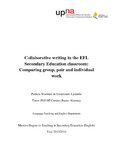Collaborative writing in the EFL Secondary Education classroom: comparing group, pair and individual work
Fecha
2016Director
Versión
Acceso abierto / Sarbide irekia
Tipo
Trabajo Fin de Máster/Master Amaierako Lana
Impacto
|
|
nodoi-noplumx
|
Resumen
This study investigates the benefits of collaborative writing (CW) tasks in a 1st ESO
setting. Based on strong socio-cognitive and communicative methodologies rationale,
studies examining the benefits of CW use in Foreign Language (FL) learning are on the
increase. However, papers about it in Spanish Secondary Education classes are scarce.
Moreover, most CW published studies have compared ind ...
[++]
This study investigates the benefits of collaborative writing (CW) tasks in a 1st ESO
setting. Based on strong socio-cognitive and communicative methodologies rationale,
studies examining the benefits of CW use in Foreign Language (FL) learning are on the
increase. However, papers about it in Spanish Secondary Education classes are scarce.
Moreover, most CW published studies have compared individuals and pairs CW
outcomes. This study is a partial replication of Fernández Dobao’s (2012) paper, in
which I analyse students’ accuracy, fluency and syntactic complexity outcomes when
writing the same text individually (n=18), in pairs (n=10) and in small groups (n=7).
Findings suggest CW and a higher number of participants in the collaboration generally
benefit texts’ accuracy, fluency and syntactic complexity. However, individually written
texts showed higher complexity via subordination than the ones written collaboratively.
Limitations of the study and its pedagogical implications are discussed. [--]
Materias
Collaborative writing,
Individual, pair and group work,
Secondary education
Titulación
Máster Universitario en Profesorado de Educación Secundaria por la Universidad Pública de Navarra /
Bigarren Hezkuntzako Irakasletzako Unibertsitate Masterra Nafarroako Unibertsitate Publikoan



